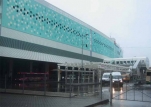Transportation Hub as an Urban Development Design

Development of the capital transportation infrastructure is one of the priorities of the Moscow City Government. Great attention is paid to the development of transport interchange hubs (TIH). Significant volumes of local-and-interurban passenger transit, carried by civil passenger transportation in Moscow and the Moscow region, the need in increasing the rate of these means and enhance the comfort of the passengers – all this brings the need for creation of new TIH s and reconstruction of existing ones in the first place amongst the priority issues of renovation of the city transport infrastructure.
The system of transportation hubs in Moscow include all major types of TIHs, ranging from the largest intermodal hubs that integrates different types of passenger transit transport, including rail handling, and also provide links to airports and public transport, and the last – local TIHs, mainly to service the neighborhoods.
So far, in the existing boundaries of Moscow are arranged 273 existing and planned transportation hubs. And if we consider Moscow as the center of the Moscow agglomeration, the boundaries of the Central Ring Road (CRR), which many experts recognize as the boundaries of the Moscow agglomeration, there are located about 90 more hubs, and in general on the territory of Moscow and Moscow region of more than 750.
Transportation and planning analysis of most TIHs shows that the conditions of the transit passengers transfer do not meet modern requirements (passengers traffic distribution is disordered, transport and pedestrian flows often are intersected, the passengers are not protected from downfall and so on), these TIHs are missing streamlined “intercepting” parking, and regularly do not meet the optimum technological requirements for the operation of passenger transportation etc..
One of the many problems of the Moscow TIHs is that planning designs in the areas of metro stations and railways were developed mainly in the beginning – middle of XX century, and therefore was based on the that time standards and calculated values of passenger ridership.
Full content of this issue you can read here
The full version of the article can be read in our printed issue, also you can subscribe to the web-version of the magazine
 Materials provided by Research and Project Institute of General Planning for the city of Moscow
Materials provided by Research and Project Institute of General Planning for the city of Moscow


